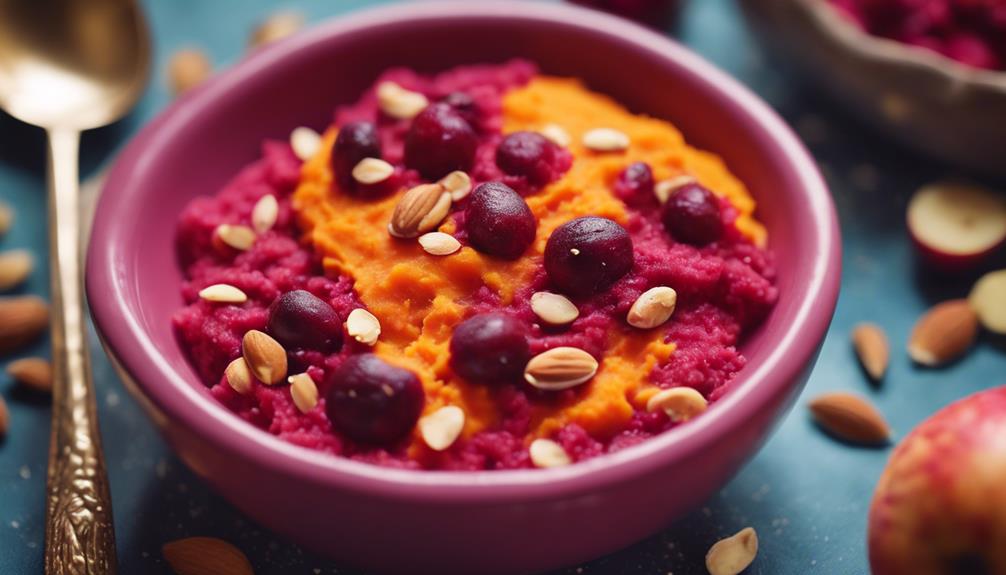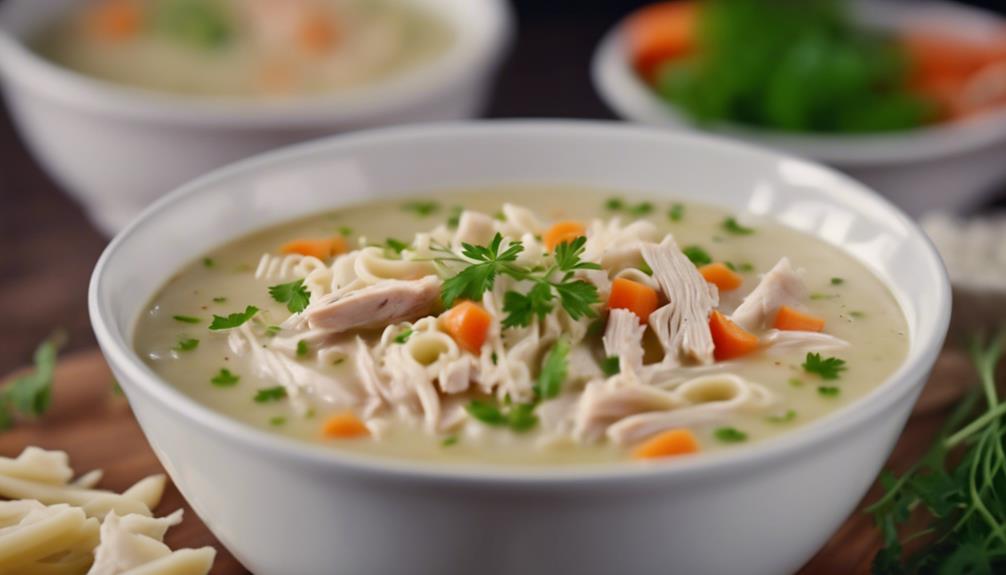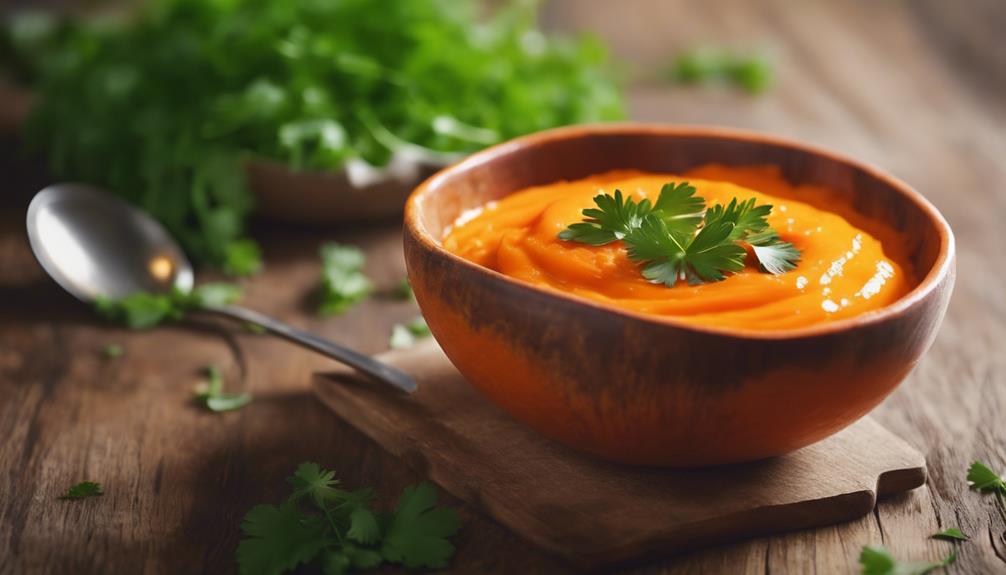Looking for something both **tasty** and **healthy**? **Cranberry baby food** is a great choice. Loaded with Vitamin C, fiber, and antioxidants, cranberries support growth and health. Start with small amounts and different options. Cook fresh ones for babies under 12 months and **ask** your doctor first. Pick firm organic cranberries and store them right. Try mixing cranberries with other fruits for yummy recipes. Cranberry baby food will **make meal times delightful** and **good for** your baby’s taste buds.
Key Takeaways
- Fresh cranberries offer tartness and nutrition for babies.
- Introduce cranberries gradually in various forms.
- Opt for homemade cranberry purees over store-bought options.
- Ensure cranberries are cooked and pureed for babies under 12 months.
- Combine cranberries with other fruits for tasty baby food recipes.
Nutritional Benefits of Cranberries for Babies
When introducing cranberries into your baby's diet, you're providing essential nutrients like Vitamin C, fiber, and polyphenols that support their immunity and overall health.
The health benefits of cranberries for babies are vast, making them a fantastic addition to their meals. Cranberries for baby consumption can aid in reducing the risk of urinary tract infections, promote healthy growth and development, and enhance their overall nutritional intake.
The goodness of cranberries lies in their high antioxidant content, which can help combat cold symptoms and support oral health by inhibiting acid production.
By incorporating cranberries into your baby's diet, you aren't only introducing a delicious and tangy flavor but also a powerhouse of nutrients that can contribute to their well-being.
Opting for fresh cranberry purees over cranberry juice guarantees that your baby receives the full nutritional benefits without any added sugars or preservatives, making it a healthy choice for their diet.
Serving Cranberries to Picky Eaters

To cater to picky eaters, consider introducing cranberries in various forms like dried snacks, in salads, or as jams to offer a range of textures and flavors.
Starting with small portions can help reduce intimidation and food waste when encouraging picky eaters to try new foods. It's important to exercise caution with small children when serving cranberries, as cutting them into smaller pieces can prevent choking hazards.
Remember to avoid pressuring children to eat cranberries; this can worsen picky eating behaviors and create aversions to the food. Encouraging a no-pressure approach is key when introducing cranberries to picky eaters, allowing them to explore and try the fruit at their own pace.
Talking to Kids About Cranberries

When talking to kids about cranberries, keep it simple by describing their red color, sweet-tart taste, and slightly bumpy texture. Encourage them to play with cranberries in fun food activities to help them get comfortable with this unique fruit.
Discuss the health benefits of cranberries like aiding digestion and providing important nutrients for their bodies.
Engaging Food Conversations
Curious about how to spark engaging food conversations with kids about cranberries? When talking to children about cranberries, use simple terms like 'tart,' 'red,' and 'small' to introduce them in a neutral way. Encourage kids to explore cranberries through food play activities like counting or squishing them, making the fruit less intimidating. Additionally, explain the nutritional benefits of cranberries, such as aiding digestion and boosting immunity, to capture kids' interest.
To dig deeper, highlight how cranberries contain fiber that helps with bowel movements, emphasizing the importance of a healthy digestive system. Engaging children in activities that involve cranberries not only makes learning fun but also fosters a positive association with this nutritious fruit.
Positive Food Associations
Introducing cranberries to kids in a neutral and positive manner sets the groundwork for fostering healthy food associations. When talking to kids about cranberries, use terms like 'red' and 'tart' to keep the introduction neutral, avoiding negative connotations.
Encourage children to explore cranberries at their own pace; this approach can help reduce any potential food aversions. Explain the benefits of cranberries, such as aiding digestion, to pique kids' interest in trying them. By providing factual information about cranberries, you can foster positive attitudes towards this fruit.
Additionally, desensitizing kids to cranberries through fun food play activities can make them more appealing and less intimidating. Remember, creating a positive environment around cranberries can help children develop a healthy relationship with this nutritious and tart fruit.
Nutritional Benefits Discussion
To engage kids in a discussion about the nutritional benefits of cranberries, emphasize their rich content of Vitamin C and polyphenols, supporting immune system strength and disease prevention.
Here are three key points to share with your children:
- Vitamin C Boost: Mention how cranberries are packed with Vitamin C, which helps our bodies fight off germs and stay healthy.
- Strong Immune System: Explain that eating cranberries can help make their immune system strong, like having an invisible shield against getting sick.
- Healthy Mouth: Let them know that cranberries can also keep their mouth healthy by preventing cavities and keeping their teeth and gums strong.
Understanding Cranberries in Kids' Bodies

Children's bodies benefit greatly from the inclusion of cranberries in their diet due to the various health advantages these fruits offer. Cranberries are a fantastic addition to a baby's diet as they are rich in dietary fiber, aiding in digestion and promoting regular bowel movements. The manganese found in cranberries plays a key role in helping children break down glucose and digest carbohydrates effectively, providing a source of energy. Moreover, the high antioxidant content in cranberries supports overall well-being in kids by boosting their immune system. Additionally, consuming cranberries can help prevent urinary tract infections in children, promoting good urinary health.
| Cranberries Benefits for Kids | |
|---|---|
| Rich in Dietary Fiber | Aids in digestion and bowel movements |
| Manganese Content | Helps in glucose breakdown and carbohydrate digestion |
| High Antioxidant Levels | Boosts the immune system for overall well-being |
| UTI Prevention | Promotes good urinary health in children |
Cranberry Food Play Activities

Food play activities with cranberries can help your child become more familiar with the texture and taste of this nutritious fruit. Engaging in these activities can reduce fear and hesitation, making cranberries more appealing to picky eaters.
Desensitization through play aims to make cranberries less intimidating and more enjoyable for children to explore.
Food Play Benefits
Engaging in playful activities with cranberries can help familiarize young ones with new textures and tastes, easing any apprehension they may have towards trying them. Here are three benefits of incorporating food play activities with cranberries:
- Desensitization: By engaging in food play activities, children can slowly become accustomed to the unique tartness of cranberries. This gradual exposure can make cranberries less intimidating and more appealing to young palates.
- Engaging Exploration: Specific activities like counting and squishing cranberries can provide children with a hands-on way to interact with these fruits. Through these interactive experiences, children can explore the textures and properties of cranberries in a fun and engaging manner.
- Encouraging Consumption: Food play serves as a powerful tool to encourage children to engage with cranberries, paving the way for them to eventually taste and enjoy these nutritious fruits. By making the experience enjoyable and interactive, children may become more open to incorporating cranberries into their diets.
Interactive Cranberry Activities
Introduce little ones to the world of cranberries through interactive activities that involve squishing and counting these vibrant fruits. Engaging in food play activities can help familiarize children with new textures and tastes, making cranberries less intimidating.
By incorporating interactive activities like squishing and counting cranberries, children can explore the fruit in a fun and non-intimidating manner. These specific activities aim to make cranberries more appealing and reduce any fear or hesitation children may have towards trying them.
Through interactive food play, children can desensitize themselves to the intimidating aspects of cranberries, paving the way for them to eventually taste the food. By engaging in these activities, children can gradually become more comfortable with the idea of trying new foods like cranberries.
Desensitization Through Play
Encourage children to playfully interact with cranberries to familiarize them with the fruit's texture and taste. By engaging in food play activities with cranberries, kids can become more comfortable with trying new foods and reduce any intimidation or fear they may have.
Here are three fun ways to incorporate desensitization through play with cranberries:
- Counting Fun: Have children count the cranberries as they play with them. This activity not only helps with numeracy skills but also allows them to get familiar with the feel of the fruit.
- Squish and Explore: Encourage kids to squish the cranberries between their fingers and explore the texture. This hands-on approach can make the fruit less intimidating and more appealing.
- Create Art: Use cranberries to create art by dipping them in paint and stamping them on paper. This creative activity can make the fruit seem more approachable and fun to interact with.
Introducing Cranberries to Babies Safely

When introducing cranberries to babies, it's important to prioritize their safety and digestive well-being by cooking or baking fresh cranberries before serving. Fresh cranberries shouldn't be given as whole berries to infants under 12 months due to the potential choking hazard they pose. Instead, consider incorporating cooked or baked cranberries into baby food recipes as a nutritious addition.
Before introducing cranberries into your baby's diet, consult a nutritionist or pediatrician to confirm it aligns with your baby's individual needs and to address any concerns. Fresh cranberries are generally safe for babies and toddlers and are recommended for introduction after 8 months of age by the FDA.
When preparing cranberries for your little one, make sure proper selection, storage, and cooking methods are followed to maintain their safety and nutritional benefits. By taking these precautions, you can introduce cranberries to your baby safely and enjoyably as a delicious finger food option.
Selecting and Storing Cranberries for Babies

To safeguard the freshness and quality of cranberries for your baby's food, start by selecting bright red, firm cranberries when shopping.
Here are some tips for selecting and storing cranberries for your little one:
- Opt for Organic Cranberries: Choose organic cranberries to minimize pesticide exposure and provide a healthier option for your baby. Organic cranberries are grown without synthetic pesticides, making them a safer choice for your baby's food.
- Choose Whole Cranberries: Fresh whole cranberries are preferred over dried cranberries or canned options with added sugars and preservatives. Whole cranberries retain more nutrients and can be easily cooked, mashed, or pureed for your baby's meals.
- Proper Storage: After cleaning the cranberries, store them in the refrigerator for up to two weeks. For longer storage, freeze the cranberries for up to 12 months to maintain their freshness. Proper storage ensures that your baby's cranberries stay fresh and safe for consumption.
Scrumptious Cranberry Recipes for Babies

Delight your little one's taste buds with a variety of nutritious and tasty cranberry recipes tailored for babies. When introducing the tartness of the cranberry to your baby, consider mixing it with other fruits to balance the flavors. Remember not to add sugar to maintain the natural goodness of the cranberries. Confirm the consistency is suitable for your baby by pureeing or mashing the cranberries properly.
Here's a table showcasing some scrumptious cranberry recipes for babies:
| Recipe | Ingredients | Age Recommendation |
|---|---|---|
| Cranberry Baby Cereal | Cranberry puree, baby cereal | 6-8 months |
| Cranberry Sauce | Cranberries, water, apple juice | 8-10 months |
| Cranberry Smoothie | Cranberry, coconut milk, banana | 10-12 months |
| Cranberry Oatmeal | Cranberries, oats, almond milk | 12-18 months |
| Cranberry Rice Pudding | Cranberry puree, rice, coconut milk | 8-10 months |
Frequently Asked Questions
Are Cranberries Good for Babies?
Yes, cranberries are good for babies. They are rich in Vitamin C, fiber, and antioxidants, which can boost immunity and aid digestion. Remember to cook or puree them to avoid choking hazards and consult a healthcare provider first.
How to Use Dried Cranberry for Babies?
To use dried cranberries for babies, soak them in water or breast milk to soften before pureeing. Opt for unsweetened varieties for added health benefits. Remember to use them in moderation to prevent overwhelming your little one with tartness and sweetness.
Can I Give My 8 Month Old Cranberry Juice?
You shouldn't give your 8-month-old cranberry juice due to its high acidity. It may cause digestive issues or reactions like rashes. Consult your pediatrician first to confirm it aligns with your baby's dietary needs.
Conclusion
To sum up, cranberries are a tart and nutritious option for babies that offer a range of health benefits. Remember, 'you are what you eat,' so why not start your little one off with the goodness of cranberries?
With creative ways to serve and enjoy this superfood, your baby will be on their way to a healthy and delicious start in life.
So go ahead, add some cranberries to your baby's diet and watch them thrive!











